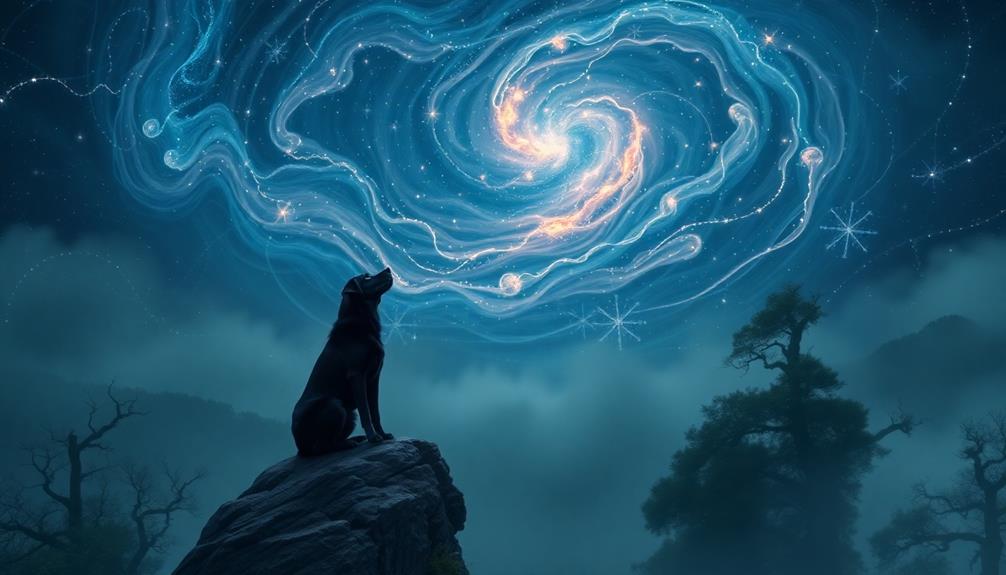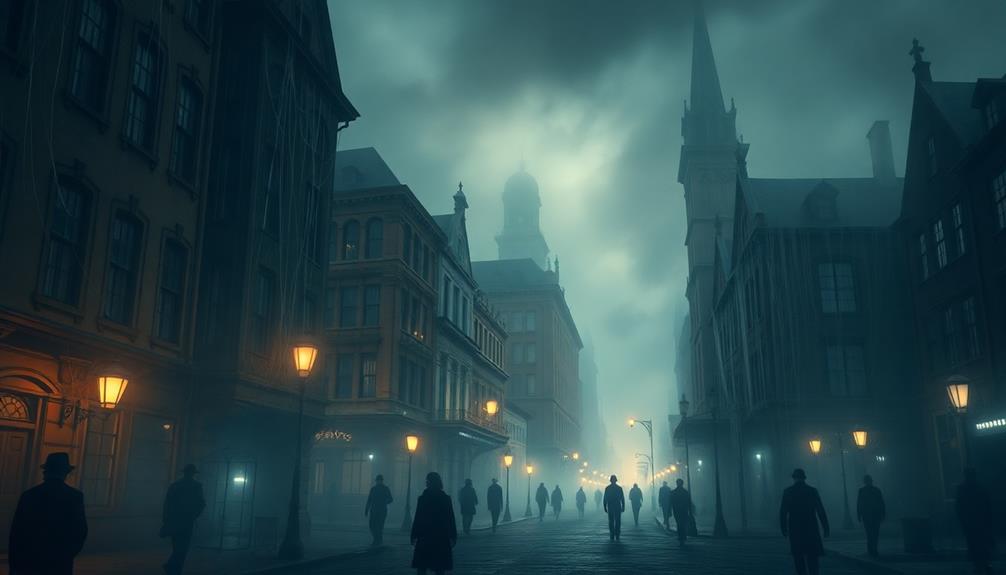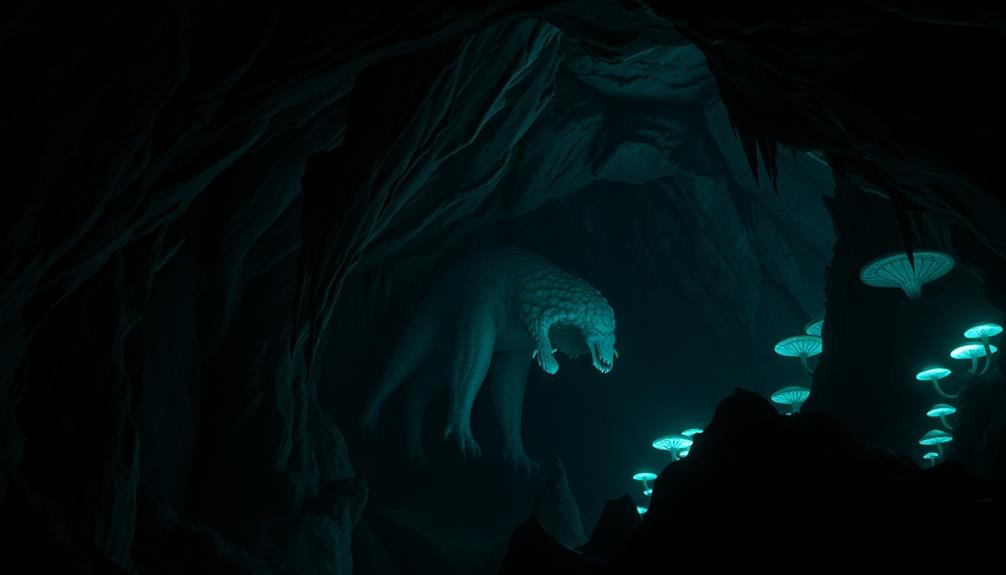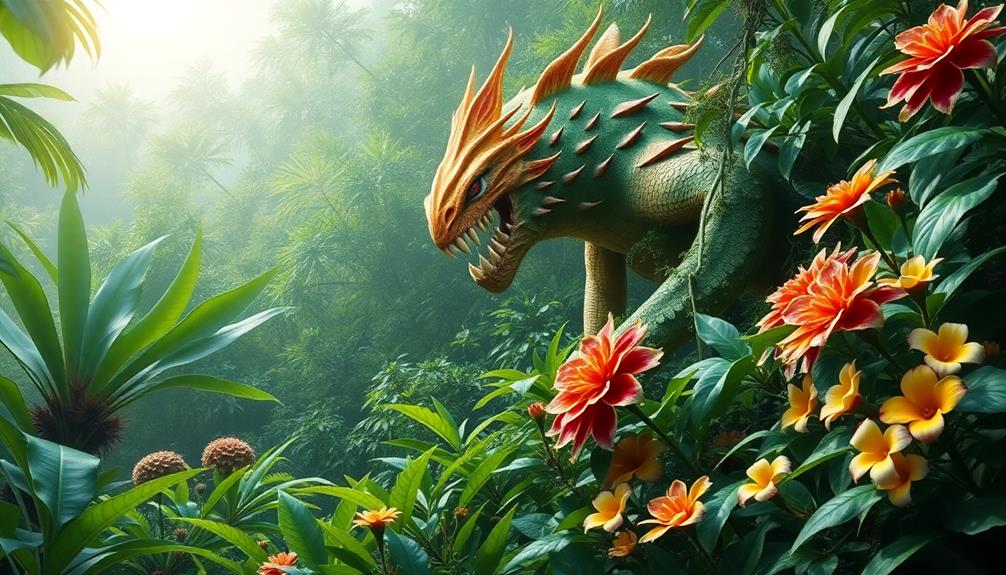If the Wampus Cat can shape-shift at will, it transforms from a simple tale into a formidable spirit. You'd see it shifting from a fearsome feline to a human or even other creatures, blending seamlessly into its surroundings. This ability amplifies its role as both protector and terror, blending the boundaries between human and animal. You might find it lurking in shadows, mimicking human cries or vanishing into thin air. Such powers enhance its mystique and deepen the cautionary lessons in its folklore. Want to explore the origins and modern interpretations of this legendary creature further?
Key Takeaways
- If the Wampus Cat can shape-shift at will, it would enhance its role as a protector, evading threats and safeguarding its territory.
- This ability would allow the Wampus Cat to blend seamlessly into various environments, making it an elusive figure in folklore.
- Shape-shifting at will could symbolize the duality of human and animal instincts, representing both vulnerability and ferocity.
- Enhanced shape-shifting abilities would reinforce its mystical presence in local mythology, captivating audiences and inspiring cautionary tales.
- Embracing this power would reflect societal values surrounding transformation, highlighting the consequences of violating sacred traditions.
Origins of the Wampus Cat
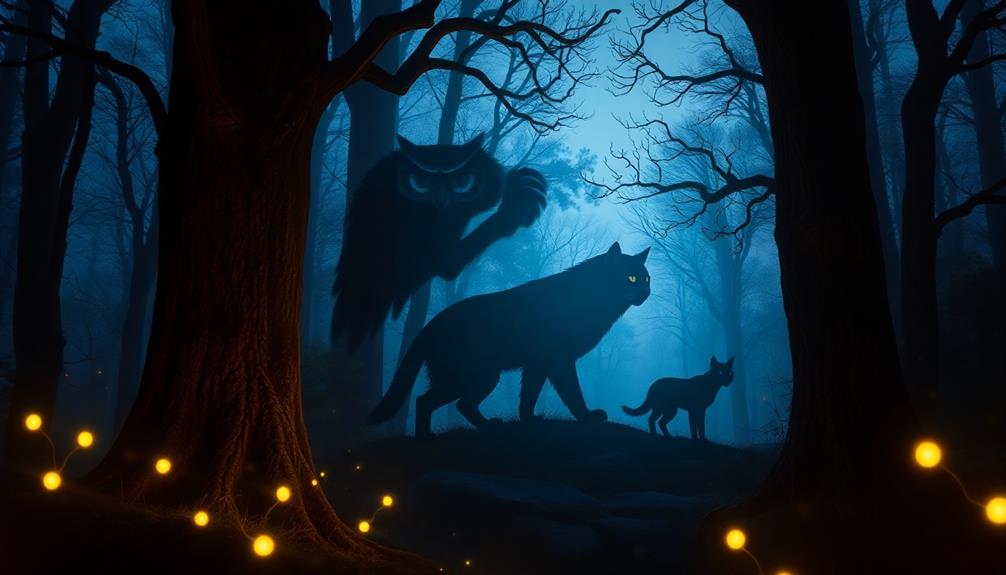
Deep within the rich tapestry of Cherokee folklore lies the intriguing legend of the Wampus Cat, a creature born from both myth and moral lessons. The origin of the Wampus is often traced back to a Cherokee woman named Running Deer, who transformed into this fearsome being after defeating the evil spirit Ewah. This act of bravery reflects the struggle against dark forces in Cherokee culture.
In another version of the story, a woman faces punishment for spying on a sacred ceremony. Her curiosity leads to a metamorphosis, turning her into the Wampus Cat as a warning against disrespecting cultural traditions. This tale emphasizes the consequences of one's actions while highlighting the importance of adhering to communal values.
Interestingly, the name "Wampus Cat" is thought to be an anglicization of "Ewah," showcasing how the legend adapted through time, especially among Appalachian settlers.
The creature symbolizes a blend of human and animal traits, embodying themes of protection and punishment. As the legend evolved, it absorbed influences from European myths, resulting in various interpretations that continue to captivate imaginations today.
Shape-Shifting Legends
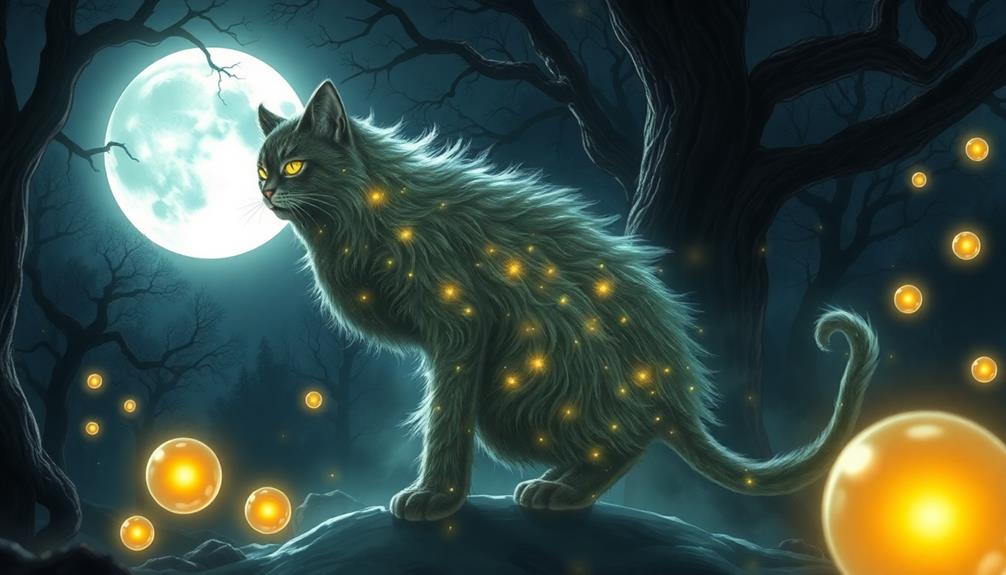
The Wampus Cat's legend is rich with shape-shifting tales that reveal its dual nature as both a protector and a warning. In the folklore of the Appalachian Mountains, this creature often embodies a cursed woman, emphasizing themes of transformation and consequence.
Similar to European myths of shape-shifting witches, the Wampus Cat is believed to possess the ability to change forms, taking on the appearance of various animals or even humans.
Encounters with the Wampus Cat frequently include reports of the creature disappearing or altering its shape to evade capture, adding to its mystical reputation. These shape-shifting abilities are thought to connect the Wampus Cat to dark forces and spiritual domains, reinforcing its role as a guardian against evil.
In modern storytelling, the shape-shifting aspect of the Wampus Cat captivates audiences, creating suspense and intrigue. Its legendary status thrives on this otherworldly nature, making it a compelling figure in Appalachian folklore.
As you explore these tales, consider how the shape-shifting legend of the Wampus Cat reflects deeper themes of transformation and the balance between protection and danger.
Cultural Interpretations

Cultural interpretations of the Wampus Cat reveal a fascinating tapestry of beliefs and values that shape its legend. In Cherokee folklore, the Wampus Cat represents a cursed woman, reflecting themes of transformation and punishment for defying sacred traditions. This narrative aligns with shape-shifting myths prevalent in European folklore, where women are often depicted as capable of transformation.
In the Appalachian region, the Wampus Cat blurs the line between human and animal, with reports of it walking on hind legs adding to its shape-shifting mystique. Its supernatural abilities, including claims of invisibility and magical eyes, further enhance the perception of this creature as a master of disguise, capable of evading detection.
These cultural narratives not only frame the Wampus Cat as a fearsome figure but also highlight the societal values surrounding transformation and consequence.
In popular culture, the Wampus Cat's shape-shifting traits continue to thrive, appearing in fantasy games and literature, reinforcing its status as an enigmatic symbol within regional folklore. You can see how these interpretations create a rich context that shapes how the Wampus Cat is understood today.
Encounters and Sightings

When you hear stories about the Wampus Cat, you can't help but feel a chill run down your spine.
Witnesses often describe its eerie transformations, where it shifts from a majestic feline to a more monstrous form, leaving you questioning what's real.
These encounters not only spark intrigue but also highlight how local mythology shapes our understanding of this elusive creature.
Eerie Transformations Observed
Numerous witnesses have recounted eerie encounters with the Wampus Cat, often describing its astonishing transformations during twilight or dawn. You might find it chilling that this creature can shift from a large feline into a shadowy figure or even a human-like form, emphasizing its haunting presence.
People have noted several unsettling characteristics during these sightings:
- Walking on hind legs – This unusual behavior adds to its otherworldly nature.
- Seamless blending – The ability to merge into surroundings enhances the mystique of its shape-shifting.
- Ghostly figures – Hikers in the Great Smoky Mountains have reported seeing it vanish suddenly, leaving spine-chilling screams behind.
- Mimicking familiar forms – Some witnesses describe the Wampus Cat imitating both animals and human silhouettes, creating confusion and fear.
These eerie transformations contribute to the Wampus Cat's legendary status, linking it to witchcraft and the supernatural.
Each encounter leaves an indelible mark on those who experience it, raising questions about what truly lurks in the shadows.
With each sighting, the legend grows, pulling you deeper into its haunting allure.
Local Mythology Influence
Throughout the Appalachian region, the influence of local mythology on the Wampus Cat's legend is profound, shaping the narratives surrounding its eerie encounters. This legendary creature is often described as a shape-shifter, capable of blending into its surroundings or adopting various forms to confuse and terrify witnesses. You might hear stories of people seeing the Wampus Cat shift from a six-legged beast to an upright figure, amplifying its unsettling reputation.
These encounters don't just involve sighting the creature; many reports detail it mimicking human screams or cries, enhancing its supernatural aura. The Wampus Cat's ability to shape-shift is deeply rooted in broader Appalachian folklore themes, particularly those surrounding witchcraft and transformation. Often, these tales involve women punished for defying sacred traditions, linking the creature's eerie presence with local mythology.
Moreover, the merging of local legends with European shape-shifting myths fosters a unique belief in the Wampus Cat's shifting nature. As you explore these tales, you can't help but feel a mix of fascination and fear, reflecting the complex cultural heritage that continues to thrive in Appalachia.
Impact on Local Folklore

When you explore the shape-shifting legends of the Wampus Cat, you'll uncover a rich tapestry of cultural significance tied to transformation.
These stories not only reflect local fears and values but also adapt to modern interpretations, keeping the folklore alive.
Understanding this impact reveals how the Wampus Cat embodies both tradition and contemporary anxieties in Appalachian communities.
Shape-shifting Legends Explained
While many legends weave through Appalachian culture, the shape-shifting tales of the Wampus Cat stand out for their rich interplay between human and animal traits. This half-cat creature embodies a blend of fear and fascination, rooted in European myths and local Cherokee folklore. Legend tells of a cursed woman who can transform at will, enhancing her fearsome reputation.
The shape-shifting nature of the Wampus Cat serves several significant functions within the community:
- Cautionary Symbol: It warns against defying sacred traditions, emphasizing respect for the supernatural.
- Duality Representation: The creature reflects the complexities of human and animal instincts, showcasing vulnerability and ferocity.
- Mystique Creation: Its ability to shift forms keeps the legend alive, sparking ongoing storytelling and intrigue among locals.
- Cultural Fusion: The merging of various folklore elements enriches the narrative, demonstrating the dynamic evolution of Appalachian legends.
As you ponder the Wampus Cat's shape-shifting capabilities, consider how these stories not only entertain but also instill essential cultural lessons, weaving a rich tapestry of myth that endures through generations.
Cultural Significance of Transformation
The transformation of the Wampus Cat holds deep cultural significance within local folklore, serving as a vivid reminder of the interplay between humanity and nature. This creature's ability to shape-shift mirrors themes found in Cherokee folklore, where legends like that of Running Deer showcase the blending of human and animal traits.
Such transformations can also reflect an individual's journey toward unlocking their inner potential through self-discovery and alignment with their desires. Through these stories, you see how shape-shifting serves as a cautionary tale, warning against the consequences of violating sacred traditions or rituals.
The Wampus Cat's transformations also highlight societal fears surrounding witchcraft and the supernatural, particularly the powerful roles of female figures in folklore. Such narratives tap into cultural identity, enriching the community's understanding of its values and fears.
Regional variations of the Wampus Cat legend emphasize unpredictability and nature's duality, embedding the creature deeper into local culture.
Ultimately, the shape-shifting lore of the Wampus Cat not only instills a sense of mystery and fear but also connects you to the land and its stories. Each encounter with this enigmatic being reinforces a shared cultural experience that transcends generations, making the Wampus Cat an enduring symbol in local folklore.
Modern Interpretations and Adaptations
In recent years, modern interpretations of the Wampus Cat have breathed new life into its legend, showcasing its shape-shifting abilities as a compelling focal point. This transformation aligns with broader themes in local folklore, particularly those tied to witchcraft.
The Wampus Cat's capacity to shift forms has made it a versatile character in contemporary storytelling, enhancing its mystique in popular culture.
Here are some key impacts of these adaptations on local folklore:
- Expanded Narratives: Stories now include accounts of the Wampus Cat transforming into various animals or even human forms.
- Cultural Reflection: These tales reflect the community's views on transformation and resilience in the face of change.
- Trickster Archetype: The Wampus Cat often embodies the trickster role, teaching lessons through its cunning and protective nature.
- Revived Interest: The shape-shifting aspect has sparked local festivals and storytelling events, celebrating its legendary status and evolving interpretations.
Through these adaptations, the Wampus Cat continues to inspire curiosity and connection, ensuring it remains a crucial part of Appalachian culture and identity.
Modern Representations

As you explore modern representations of the Wampus Cat, you'll find that its shape-shifting abilities are a central theme, deeply rooted in folklore and witchcraft. This creature often appears as a shape-shifter in various forms across popular culture, showcasing its supernatural abilities.
In fantasy games like Dungeons & Dragons, the Wampus Cat enhances gameplay dynamics through its transformative powers, allowing players to experience the thrill of its elusive nature.
In literature, Cormac McCarthy's "The Orchard Keeper" highlights the Wampus Cat's knack for blending into its surroundings, reinforcing its mystical qualities. The Harry Potter universe also features the Wampus Cat as one of the four houses at Ilvermorny School of Witchcraft, symbolizing the intriguing interplay between human and animal traits through its magical attributes.
Additionally, contemporary paranormal investigations frequently report sightings of a Wampus Cat exhibiting shape-shifting characteristics. These accounts contribute to its reputation as a mysterious and formidable entity, ensuring that the Wampus Cat remains a fascinating subject in modern representations of folklore.
With each portrayal, the Wampus Cat continues to captivate and intrigue, embodying the essence of shape-shifting legends.
Symbolism and Meaning

Exploring the symbolism of the Wampus Cat reveals a rich tapestry of meaning woven into its shape-shifting abilities.
This creature's transformations highlight the complexities of identity and the duality of nature, making it a profound figure in folklore.
Here are four key themes that encapsulate its significance:
- Merging of Traits: The Wampus Cat embodies both human and animal characteristics, symbolizing our connection to the natural world.
- Consequences of Actions: Its shape-shifting often serves as a cautionary tale, reminding you that violating sacred traditions can lead to dire repercussions.
- Supernatural Fears: The association with witchcraft reflects cultural beliefs and the community's fears regarding the unknown.
- Guardian Spirit: In Cherokee mythology, the Wampus Cat represents the struggle between good and evil, acting as a protector against dark forces.
These layers of meaning illustrate the Wampus Cat as not only a mythical creature but also a guardian spirit, emphasizing the intricate relationship between humanity and nature.
Understanding its symbolism encourages a deeper appreciation for the values and lessons embedded within these stories.
The Wampus Cat Today

The Wampus Cat has evolved in modern culture, enchanting the imagination with its shape-shifting prowess. Today, this creature is often depicted as a supernatural being capable of transforming into various forms, further enhancing its mystique. Recent sightings suggest that the Wampus Cat might even walk on hind legs, blurring the line between animal and human. This behavior fuels theories about its shape-shifting abilities and adaptability in folklore.
In areas like the Great Smoky Mountains, paranormal investigations have reported eerie screams that hint at the Wampus Cat's presence. These auditory phenomena showcase its capacity to mimic sounds, making it a master of stealth. Legends assert that its shape-shifting skills allow it to blend seamlessly into its surroundings, amplifying its enigmatic nature.
Modern representations of the Wampus Cat in literature and gaming often highlight its dual role as both a protector and a terrifying entity. This shape-shifting creature continues to captivate audiences, reminding us of the supernatural elements woven into our cultural narratives.
As you explore these tales, consider how the Wampus Cat embodies the fears and wonders of the unknown in today's world.
Conclusion
In the grand tapestry of folklore, the Wampus Cat remains a fascinating thread, weaving together mystery and intrigue. If this elusive creature truly possesses the art of shape-shifting, it invites a deeper reflection on the fluidity of identity and the shadows lurking in our own lives. So, as you wander through the tales spun by generations, remember that the Wampus Cat isn't just a creature of the night; it's a reminder that not everything is as it seems.



